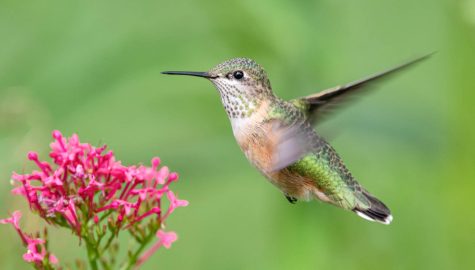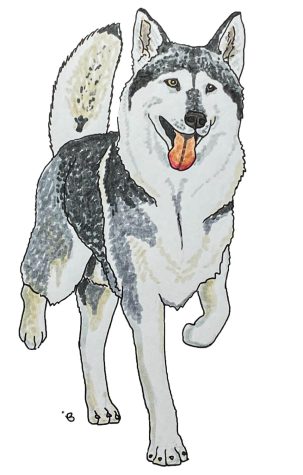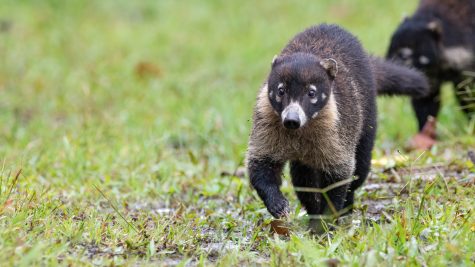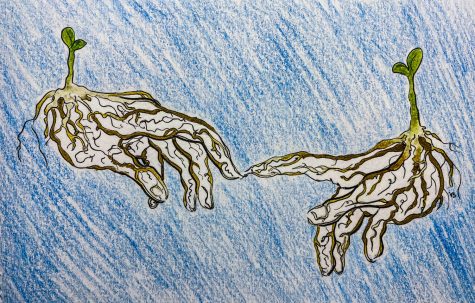Science of sleep
Species throughout nature have devised variety of solutions for snoozing
April 21, 2022
Especially for college students, sleep is a vital resource! Getting enough hours a night may pose a constant challenge for us, but many species in the animal world evolved clever ways to sneak in some shuteye.
Many animals, like humans, are monophasic sleepers, which means they sleep during one large period each day, according to National Geographic. Other species are polyphasic, sleeping in shorter chunks throughout the day; lions lay in the shade and average around 18 hours of cat naps every 24 hours.
Many prey animals are too vulnerable to predators when they are lying down, so they devised a solution: locking their legs. Thanks to this ability, horses can sleep standing up, according to Smithsonian Magazine. They sleep like this most of the time but will lay down to sleep if they feel sufficiently safe. Predation, along with the sheer amount of time they must spend foraging, is why some herbivores sleep a mere three hours a day.
Vulnerable marine mammals have interesting solutions for staying safe while asleep, too. Walruses will reportedly hook a tusk onto an iceberg while they sleep to keep them from floating away, according to the BBC Earth. Sea otters wrap themselves in kelp and hold onto each other’s paws to avoid drifting apart as they snooze.
Mammals living in the depths of the ocean still need to sleep, but it is a bit more complicated. Since they have to come up periodically to breathe, most cannot simply go to sleep for hours at a time. Instead, they only sleep halfway … literally!
Dolphins enter unihemispheric sleep, resting only half of their brain at a time and keeping one eye open, according to National Geographic. This way, they get the rest they need while swimming, breathing and staying alert for predators.
Sharks must also balance sleeping with breathing. Although sharks do not have to surface to breathe like mammals, they must keep swimming. If water is not constantly passing over their gills, they will not absorb oxygen and will effectively drown. So, sharks must sleep while swimming, according to researchers from La Trobe University in Melbourne, Australia.
The ocean poses a big challenge for sleep, but so do the skies. Many birds sleep at night while they roost, but hummingbirds take it to the next level. They have such a high metabolism that they would starve if they slept overnight.
Instead, they slow their metabolism and enter torpor, according to Science. In this near motionless state, they cool their body temperature and their heart rate may drop below 5% of its normal rate. Torpor is not sleep; it is an extreme form of energy conservation.
Many animals hibernate, but none except hummingbirds make torpor a daily habit. By going into torpor every night, hummingbirds conserve enough calories to wake up and forage each morning.
However, many migratory birds do not have time to stop and sleep at night. Alpine swifts can fly non-stop for 200 days and sleep on the wing, according to research conducted by the Swiss Ornithological Institute. Frigatebirds, which spend much of their lives at sea, also enter unihemispheric sleep while they fly, according to National Geographic.
Unlike in bihemispheric sleep – where both hemispheres of the brain are resting – unihemispheric sleepers never enter the REM stage, according to National Geographic. REM stands for rapid eye movement, a special type of sleep that humans and various other species enter during deep sleep.
Humans tend to enter REM sleep about an hour after going to sleep, according to the Sleep Foundation. In REM sleep, muscles are temporarily immobilized, giving the brain time to rest and the body a chance to heal. It is why you need more sleep when you’re sick or injured. REM sleep is also when the sleeping brain is most active and produces vivid dreams.
Cats and dogs also enter REM sleep and dream, according to National Geographic. If you see their whiskers or paws twitching in their sleep, or if they are making muffled sounds, they are most likely dreaming.
There is also recent evidence that other types of animals, like octopuses and cuttlefish, experience REM sleep and dream, according to Scientific American. Rats replay portions of their daytime activities in their dreams, similar to how humans do, according to researchers from MIT.
The clever ways animals snooze should remind you of the importance of sleep, especially with finals week approaching. Pulling an all-nighter is not as helpful as one might think. A lack of sleep is significantly detrimental to cognitive functions like focus, learning and memory, according to Harvard Medical School. So, study hard during the day and get a good six to eight hours a night, per the recommendation of the CDC. Sleep is key to success.


















